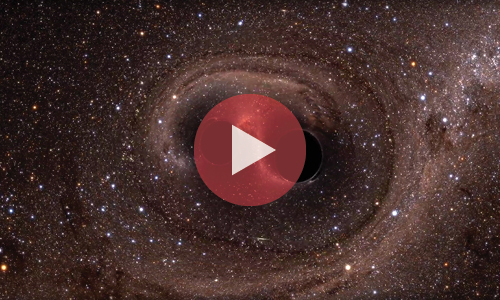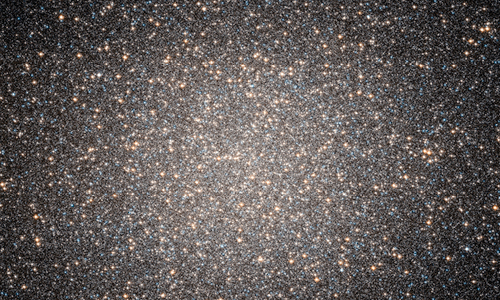|
|
|
|
|
|
| |
|
|
| |
Stephen Hawking showed that black holes are shrinking. LIGO proved they're real. |
|
| |
|
|
|
| |
|
|
| |
|
|
| |
| |
|
|
| |
An artist's impression of gravitational waves generated by binary neutron stars. (Illustration courtesy R. Hurt/Caltech-JPL) |
|
| |
|
|
|
|
| |
|
|
|
| |
|
|
| |
The world lost a far-reaching scientific mind when Stephen Hawking died in March. Colleagues, scientists inspired by him, and fans have been paying tribute to the man who made giant strides in explaining the nature of the universe's most extreme objects: black holes, a subject well researched by University of Chicago scientists. |
|
| |
|
|
|
| |
|
|
| |
UChicago physicist Daniel Holz, SM'94, PhD'98, wrote an appreciation of Hawking's legacy for the Bulletin of the Atomic Scientists, explaining that when Hawking applied quantum mechanics to the classical physics of black holes, they appeared to leak particles. That loss means black holes have a temperature and should evaporate and, at the very end, explode. |
|
| |
|
|
|
| |
|
|
| |
This discovery, says Holz, "is one of the most beautiful and profound accomplishments of humankind, bar none." |
|
| |
|
|
|
| |
|
|
| |
Holz is a member of the Laser Interferometer Gravitational-Wave Observatory (LIGO) collaboration, founded in 1997 to search for ripples in space-time, which would confirm a key part of Albert Einstein's 1915 general theory of relativity. |
|
| |
|
|
|
| |
|
|
| |
Part of that theory states that there should be mysterious regions of space-time with insurmountable gravity--even light can't escape. These "singularities" are at the center of what are now called black holes. |
|
| |
|
|
|
| |
|
|
| |
In September 2015 LIGO detected gravitational waves, and since then the ripples have been coming, well, in waves. The discovery not only confirms Einstein's century-old theory but also marks the beginning of a new era in astrophysics. |
|
| |
|
|
|
| |
|
|
| |
|
|
| |
| |
|
|
| |
An animation shows two black holes colliding, producing the kinds of gravitational waves detected by LIGO. |
|
| |
|
|
|
|
| |
|
|
|
|
|
| |
|
|
| |
"For a long time people thought they weren't real," says Holz, that black holes "were some extreme, mathematical thought experiment that we could never hope to prove and that probably didn't exist in nature." Black holes don't emit light and thus can't be observed directly. Astrophysicists could only infer their existence by looking at their presumed effect on the surrounding universe, such as the way light bends. |
|
| |
|
|
|
| |
|
|
| |
"By detecting gravitational waves and measuring them, we've shown that black holes do in fact exist, and behave the way Einstein predicted." |
|
| |
|
|
|
|
|
| |
|
|
| |
Six more things about black holes |
|
| |
|
|
|
| |
|
|
| |
|
|
|
| With his trademark humor and relatable language, Hawking gives a brief history of black holes. |
|
|
|
| |
|
|
|
|
|
| |
|
|
| |
|
|
|
| It took Subrahmanyan Chandrasekhar, the UChicago Nobel laureate who first proposed that stars could collapse into black holes, 40 years to convince the world. |
|
|
|
| |
|
|
|
|
|
| |
|
|
| |
|
|
|
| Using the Chandra X-ray Observatory, astronomers estimate that the supermassive black hole in the center of our galaxy is surrounded by 10,000 other black holes. |
|
|
|
| |
|
|
|
|
|
| |
|
|
| |
|
|
|
| The South Pole Telescope has joined the Event Horizon Telescope, a virtual Earth-sized telescope aiming to capture the first photograph of a black hole. |
|
|
|
| |
|
|
|
|
|
| |
|
|
| |
|
|
|
| Computational astrophysicists developed a new method to study supernovae and black holes in a laboratory setting by analyzing their magnetic fields. |
|
|
|
| |
|
|
|
|
|
| |
|
|
| |
|
|
|
| An ultracold state called "quantum criticality" hints at similarities between such diverse phenomena as black hole gravitational dynamics or the exotic conditions that prevailed at the birth of the universe. |
|
|
|
| |
|
|
|
|
|
|
|
|
|
| |
|
|
| |
|
|
| |
| |
|
|
| |
A 2008 Hubble image of Omega Centauri, revealing that the cluster appears to harbor an elusive intermediate-mass black hole in its center. (Photo courtesy NASA, ESA, and the Hubble Heritage Team [STScI/AURA]) |
|
| |
|
|
|
|
| |
|
|
|
| |
|
|
| |
T. S. Eliot Prize-winning poet Sarah Howe was commissioned to write a poem on light for the UK's 2015 National Poetry Day. Her first thought was "of its absence: the black holes whose mysteries Professor Hawking has spent his career working to unfold." |
|
| |
|
|
|
| |
|
|
| |
For National Poetry Month here in the United States, read Howe's sonnet, dedicated to Hawking, and about the physics that helped shape her poetry. Then listen to it read by Hawking himself. |
|
| |
|
|
|
|
|
|
|
|
|
| |
|
|
| |
Sensor tech:
The Thoreau network tests soil and sensor capabilities.
|
| |
|
|
|
|
| |
Win this mug:
Forward µChicago, and we'll enter you in our monthly drawing.
|
| |
|
|
|
|
|
|
|
|
|
|
| |
|
|
| |
| |
|
|
| |
Good things come to those who share! Forward µChicago to a friend and be entered to win a prize. Congratulations to last month's contest winner, Elizabeth Goodman.
Sign up to receive µChicago monthly. |
|
| |
|
|
|
|
| |
|
|
|







